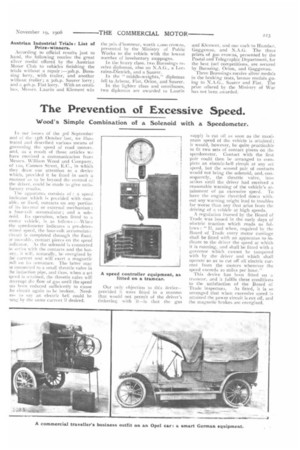The Prevention of Excessive Speed.
Page 17

If you've noticed an error in this article please click here to report it so we can fix it.
Wood' s Simple Combination of a Solenoid with a Speedometer.
In our issues of the 3rd September and of the 15th October last, we illustrated and described various means of governing the speed of road motors, and, as a result of those articles we have received a communication from Messrs. William Wood and Company, of Ito, Cannon Street, E.G., in which they draw our attention to a device which, provided it be fitted in such a manner as to be beyond the control of the driver, could be made to give satisfactory results.
The apparatus consists of : a speed indicator which is provided with movable, or fixed, contacts on any portion of its ink rnal or external mechanism; a four-volt accumulator; and a solenoid. lis operation, when fitted to ii motor vehicle, is as follows :—When the speedometer indicates a pre-determined speed, the four-volt accumulate:circuit is completed through the fixed, ar movable, contact pieces on the speed indicator. As the solenoid is connected in series with the contacts and the batcry, it will, naturally, be energised by :he current and will exert a magnetic 7,ull on its armature. The latter mac )e connected to a small throttle valve in :he induction pipe, and thus, when a set Teed is attained, the throttle valve will nterrupt the flow of gas until the speed las been reduced sufficiently to cause he circuit again to be broken. Needesto say an electric bell could be
• ung by the same current if desired. Our only objection to this device— provided it were fitted in a mannet that would not permit of the driver's tinkering with it—is that the gas
supply is cut oft as soon as the maximum speed of the vehicle is attained; it would, however, be quite practicable to fit two sets of contact pieces on the speedometer. Contact with the first pair could then be arranged to complete an electric-bell circuit at any set speed, but the second pair of contacts would not bring the solenoid, and, consequently, the throttle valve, into action until the driver had received a reasonable warning of the vehicle's attainment of an excessive speed. To have the engine throttled down without any warning might lead to troubles far worse than any that arise from the driving of a vehicle at high speeds.
A regulation framed by the Board of Trade was issued in the early days of electric traction which reads as follows : " If, and when, required by the Board of Trade every motor carriage shall be fitted with an apparatus to indicate to the driver the speed at which it is running, and shall be fitted with a governor which cannot be tampered with by the driver and which shall operate so as to cut off all electric current from the motors whenever the speed exceeds io miles per hour."
This device has been fitted on a tramcar, and it fulfils these conditions to the satisfaction of the Board of Trade inspectors. As fitted, it is so arranged that when excessive speed is attained the power circuit is cut off, and the magnetic brakes are energised.




















